ECU MAZDA MODEL 6 2017 Owners Manual (in English)
[x] Cancel search | Manufacturer: MAZDA, Model Year: 2017, Model line: MODEL 6, Model: MAZDA MODEL 6 2017Pages: 578, PDF Size: 54.72 MB
Page 14 of 578
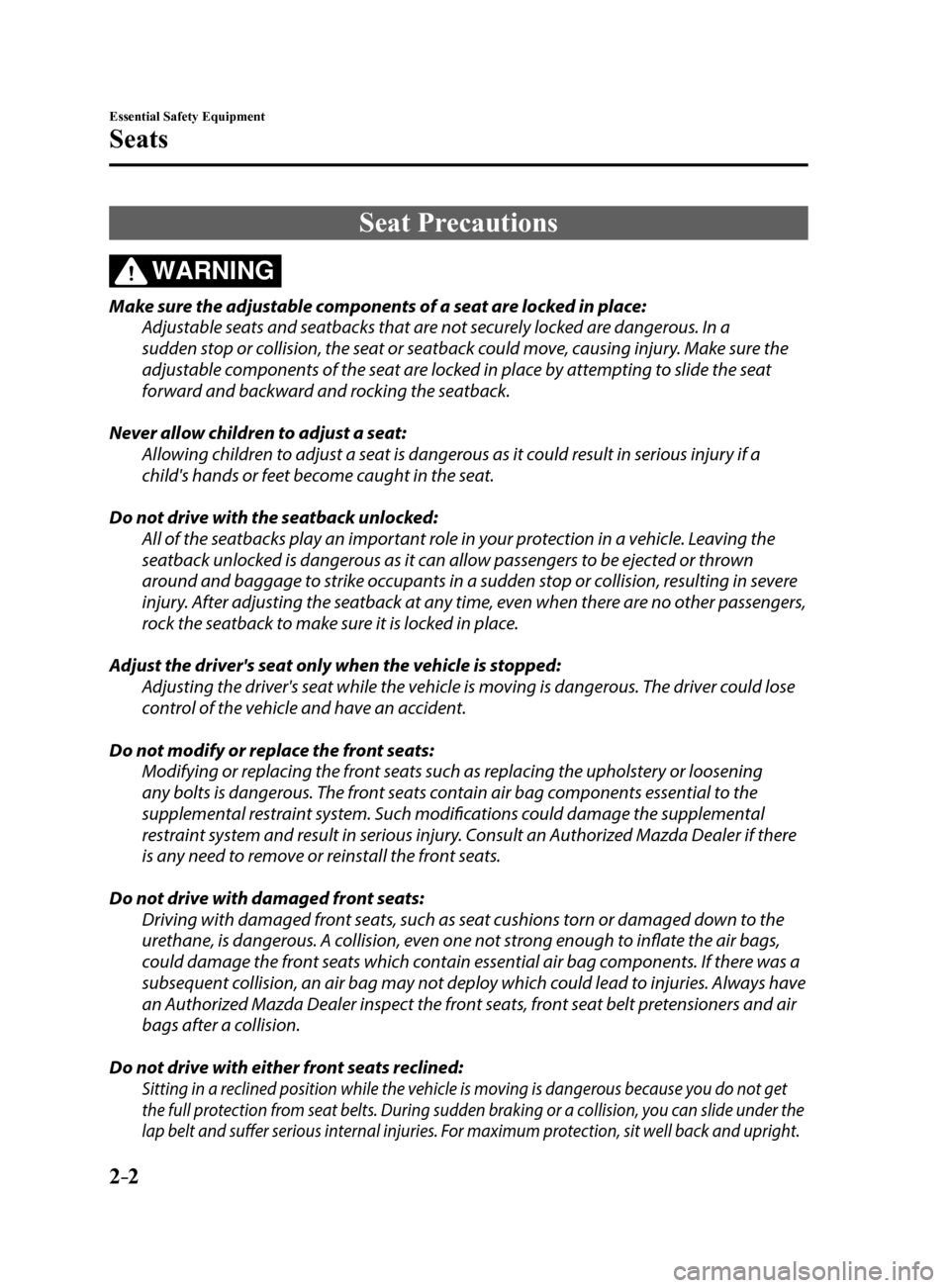
2–2
Essential Safety Equipment
Seats
Seat Precautions
WARNING
Make sure the adjustable components of a seat are locked in place:Adjustable seats and seatbacks that are not securely locked are dangerous. In a
sudden stop or collision, the seat or seatback could move, causing injury. Make sure the
adjustable components of the seat are locked in place by attempting to slide the seat
forward and backward and rocking the seatback.
Never allow children to adjust a seat: Allowing children to adjust a seat is dangerous as it could result in serious injury if a
child's hands or feet become caught in the seat.
Do not drive with the seatback unlocked: All of the seatbacks play an important role in your protection in a vehicle. Leaving the
seatback unlocked is dangerous as it can allow passengers to be ejected or thrown
around and baggage to strike occupants in a sudden stop or collision, resulting in severe
injury. After adjusting the seatback at any time, even when there are no other passengers,
rock the seatback to make sure it is locked in place.
Adjust the driver's seat only when the vehicle is stopped: Adjusting the driver's seat while the vehicle is moving is dangerous. The driver could lose
control of the vehicle and have an accident.
Do not modify or replace the front seats: Modifying or replacing the front seats such as replacing the upholstery or loosening
any bolts is dangerous. The front seats contain air bag components essential to the
supplemental restraint system. Such modifications could damage the supplemental
restraint system and result in serious injury. Consult an Authorized Mazda Dealer if there
is any need to remove or reinstall the front seats.
Do not drive with damaged front seats: Driving with damaged front seats, such as seat cushions torn or damaged down to the
urethane, is dangerous. A collision, even one not strong enough to inflate the air bags,
could damage the front seats which contain essential air bag components. If there was a
subsequent collision, an air bag may not deploy which could lead to injuries. Always have
an Authorized Mazda Dealer inspect the front seats, front seat belt pretensioners and air
bags after a collision.
Do not drive with either front seats reclined:
Sitting in a reclined position while the vehicle is moving is dangerous because you do not get
the full protection from seat belts. During sudden braking or a collision, you can slide under the
lap belt and suffer serious internal injuries. For maximum protection, sit well back and upright.
Mazda6_8FH2-EA-16F_Edition2.indb 22016/07/07 13:44:09
Page 15 of 578

2–3
Essential Safety Equipment
Seats
Do not place an object such as a cushion between the seatback and your back:Putting an object such as a cushion between the seatback and your back is dangerous
because you will be unable to maintain a safe driving posture and the seat belt cannot
function at its full capacity in a collision, which could result in a serious accident, injury or
death.
Do not place objects under the seat: The object could get stuck and cause the seat to not be fixed securely, and result in an
accident.
Do not stack cargo higher than the seatbacks: Stacking luggage or other cargo higher than the seatbacks is dangerous. During sudden
braking or a collision, objects can fly around and become projectiles that may hit and
injure passengers.
Make sure luggage and cargo is secured before driving: Not securing cargo while driving is dangerous as it could move or be crushed during
sudden braking or a collision and cause injury.
Never allow a passenger to sit or stand on the folded seatback while the vehicle is
moving: Driving with a passenger on the folded seatback is dangerous. Allowing a child to sit up
on the folded seatback while the vehicle is moving is particularly dangerous. In a sudden
stop or even a minor collision, a child not in a proper seat or child-restraint system and
seat belt could be thrown forward, back or even out of the vehicle resulting in serious
injuries or death. The child in the baggage area could be thrown into other occupants
and cause serious injury.
Never give the car keys to children and do not allow them to play in the vehicle: Playing with the folding rear seats is dangerous. Once the seatbacks are back up, a child
in the trunk would not be able to get out the way they had entered. If you have small
children, keep the seatbacks locked.
Always leave your car locked and keep the car keys safely away from children: Leaving your car unlocked or the keys in reach of children is dangerous. Children who find
their way into the trunk through an unlocked rear seatback or an open trunk can become
accidentally locked in the trunk. This could result in death or brain damage from heat
prostration, particularly in the summer. Always lock the doors and the trunk, and as an
added measure, keep the rear seatbacks locked, whether you have children in your home
or not.
Mazda6_8FH2-EA-16F_Edition2.indb 32016/07/07 13:44:09
Page 23 of 578
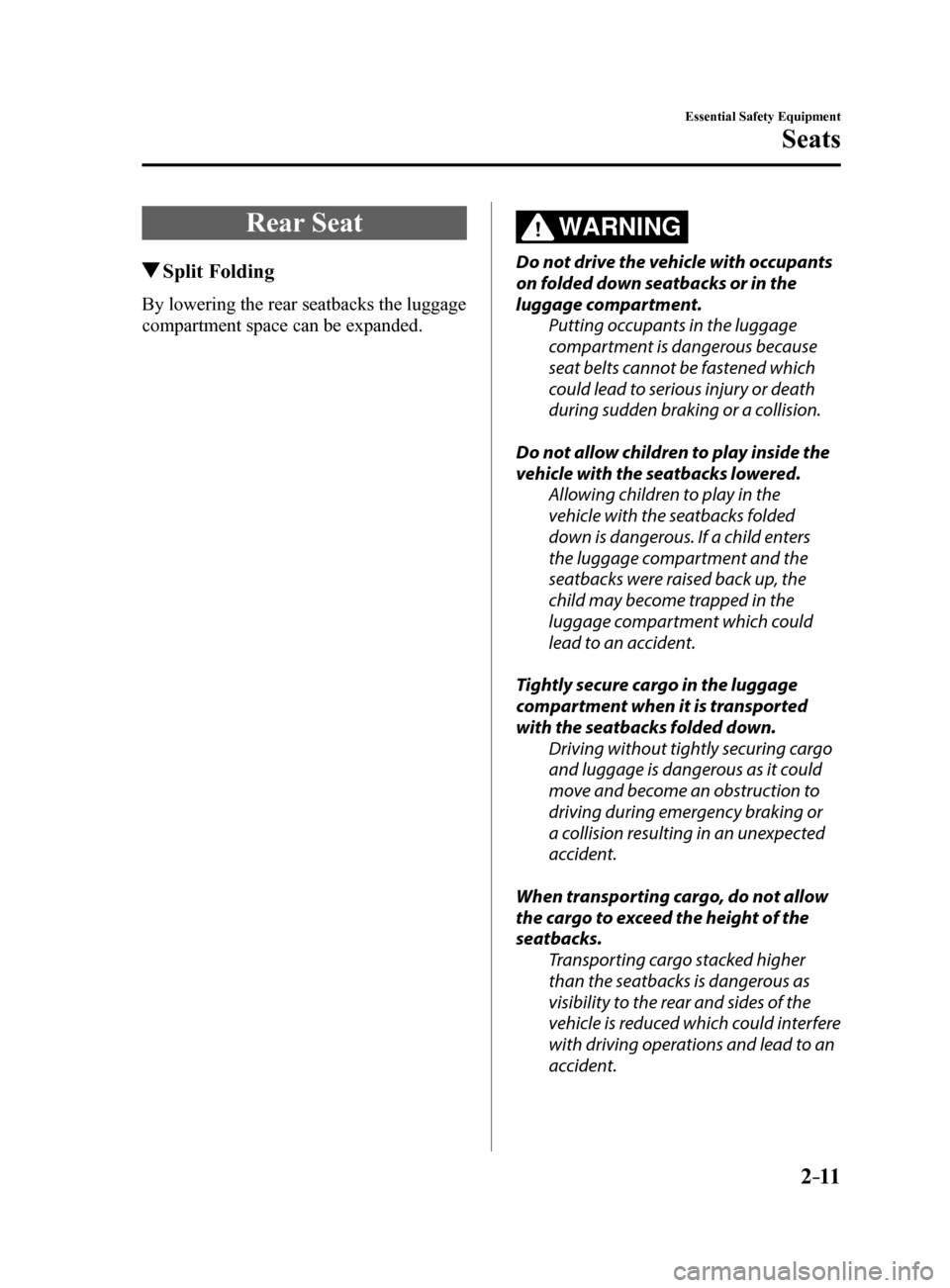
2–11
Essential Safety Equipment
Seats
Rear Seat
Split Folding
By lowering the rear seatbacks the luggage
compartment space can be expanded.
WARNING
Do not drive the vehicle with occupants
on folded down seatbacks or in the
luggage compartment.Putting occupants in the luggage
compartment is dangerous because
seat belts cannot be fastened which
could lead to serious injury or death
during sudden braking or a collision.
Do not allow children to play inside the
vehicle with the seatbacks lowered. Allowing children to play in the
vehicle with the seatbacks folded
down is dangerous. If a child enters
the luggage compartment and the
seatbacks were raised back up, the
child may become trapped in the
luggage compartment which could
lead to an accident.
Tightly secure cargo in the luggage
compartment when it is transported
with the seatbacks folded down. Driving without tightly securing cargo
and luggage is dangerous as it could
move and become an obstruction to
driving during emergency braking or
a collision resulting in an unexpected
accident.
When transporting cargo, do not allow
the cargo to exceed the height of the
seatbacks. Transporting cargo stacked higher
than the seatbacks is dangerous as
visibility to the rear and sides of the
vehicle is reduced which could interfere
with driving operations and lead to an
accident.
Mazda6_8FH2-EA-16F_Edition2.indb 112016/07/07 13:44:11
Page 24 of 578
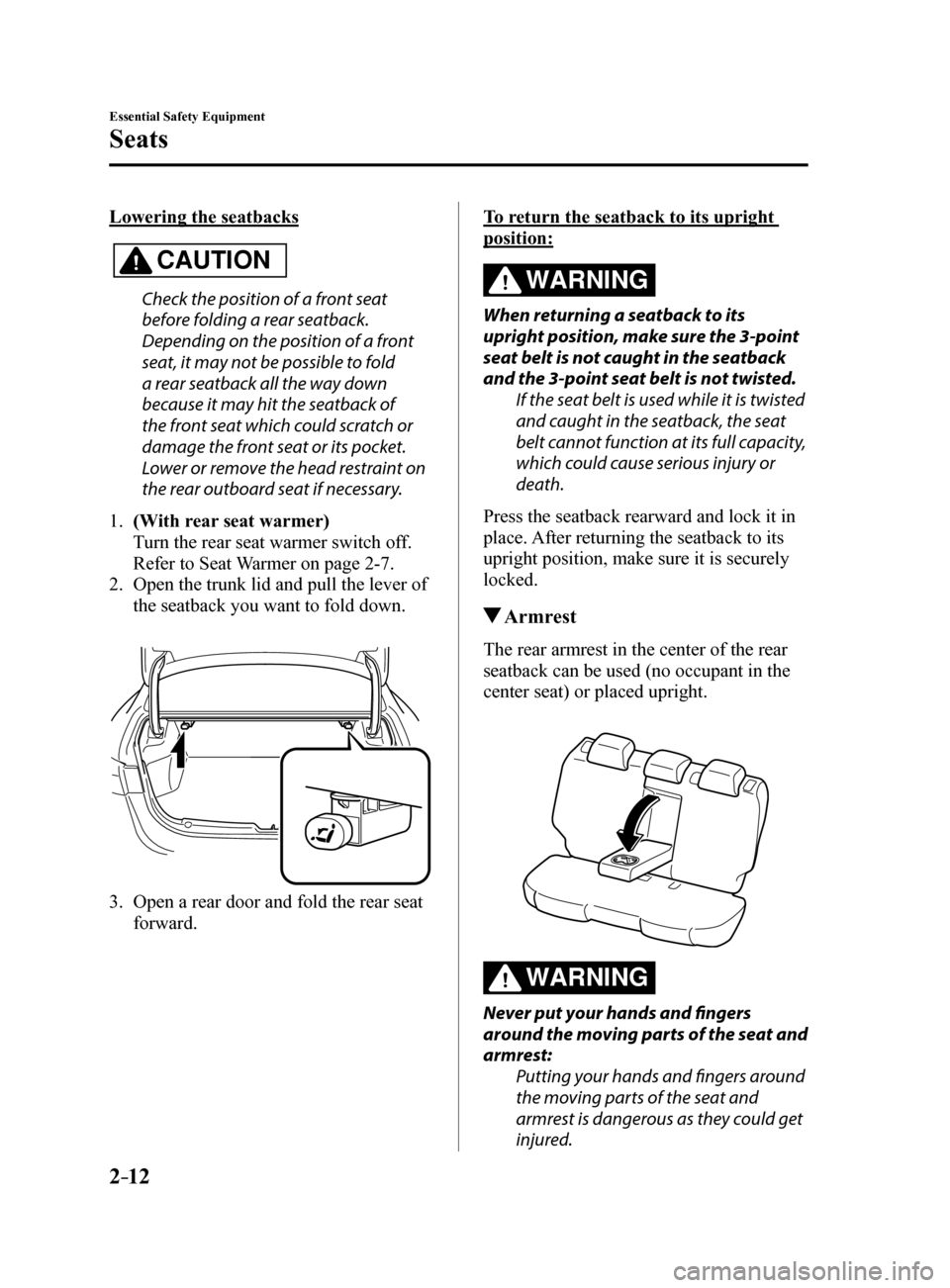
2–12
Essential Safety Equipment
Seats
Lowering the seatbacks
CAUTION
Check the position of a front seat
before folding a rear seatback.
Depending on the position of a front
seat, it may not be possible to fold
a rear seatback all the way down
because it may hit the seatback of
the front seat which could scratch or
damage the front seat or its pocket.
Lower or remove the head restraint on
the rear outboard seat if necessary.
1. (With rear seat warmer)
Turn the rear seat warmer switch off.
Refer to Seat Warmer on page 2-7.
2. Open the trunk lid and pull the lever of
the seatback you want to fold down.
3. Open a rear door and fold the rear seat
forward.
To return the seatback to its upright
position:
WARNING
When returning a seatback to its
upright position, make sure the 3-point
seat belt is not caught in the seatback
and the 3-point seat belt is not twisted.
If the seat belt is used while it is twisted
and caught in the seatback, the seat
belt cannot function at its full capacity,
which could cause serious injury or
death.
Press the seatback rearward and lock it in
place. After returning the seatback to its
upright position, make sure it is securely
locked.
Armrest
The rear armrest in the center of the rear
seatback can be used (no occupant in the
center seat) or placed upright.
WARNING
Never put your hands and fingers
around the moving parts of the seat and
armrest: Putting your hands and fingers around
the moving parts of the seat and
armrest is dangerous as they could get
injured.
Mazda6_8FH2-EA-16F_Edition2.indb 122016/07/07 13:44:11
Page 26 of 578

2–14
Essential Safety Equipment
Seats
Removal/Installation
To remove the head restraint, pull it up
while pressing the stop-catch.
To install the head restraint, insert the legs
into the holes while pressing the stop-
catch.
WARNING
Always drive with the head restraints
installed when seats are being used and
make sure they are properly installed:Driving with the head restraints not
installed is dangerous. With no support
behind your head, your neck could be
seriously injured in a collision.
After installing a head restraint, try
lifting it to make sure that it does not
pull out: Driving with an unsecured head
restraint is dangerous as the
effectiveness of the head restraint will
be compromised which could cause it
to unexpectedly detach from the seat.
CAUTION
When installing a head restraint, make
sure that it is installed correctly with
the front of the head restraint facing
forward. If the head restraint is installed
incorrectly, it could detach from the seat
during a collision and result in injury.
The head restraints on each of the front
and rear seats are specialized to each
seat. Do not switch around the head
restraint positions. If a head restraint is
not installed to its correct seat position,
the effectiveness of the head restraint
during a collision will be compromised
which could cause injury.
Mazda6_8FH2-EA-16F_Edition2.indb 142016/07/07 13:44:12
Page 27 of 578
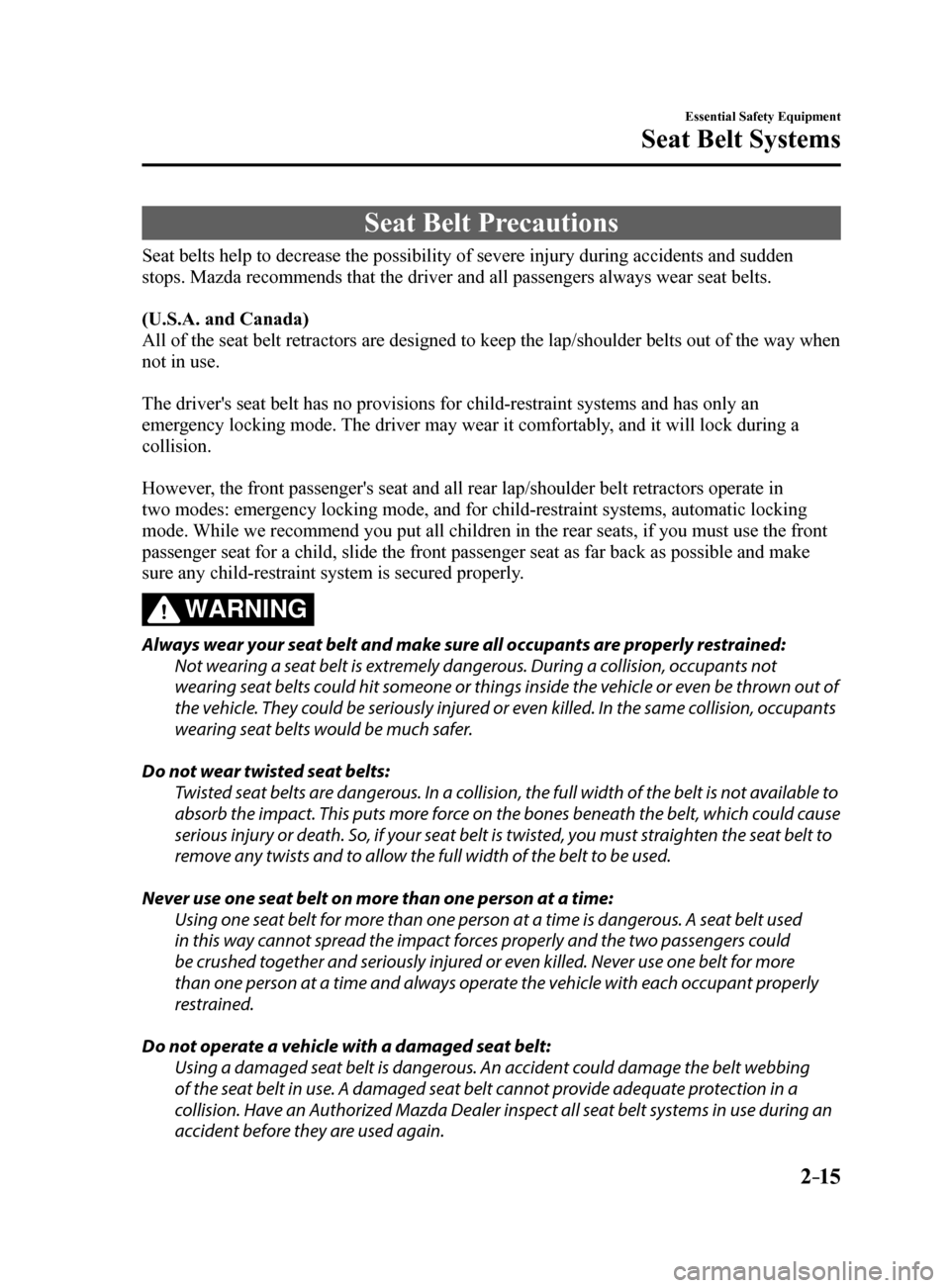
2–15
Essential Safety Equipment
Seat Belt Systems
Seat Belt Precautions
Seat belts help to decrease the possibility of severe injury during acci\
dents and sudden
stops. Mazda recommends that the driver and all passengers always wear s\
eat belts.
(U.S.A. and Canada)
All of the seat belt retractors are designed to keep the lap/shoulder be\
lts out of the way when
not in use.
The driver's seat belt has no provisions for child-restraint systems and\
has only an
emergency locking mode. The driver may wear it comfortably, and it will lock during a
collision.
However, the front passenger's seat and all rear lap/shoulder belt retractors o\
perate in
two modes: emergency locking mode, and for child-restraint systems, automatic locking
mode. While we recommend you put all children in the rear seats, if you must u\
se the front
passenger seat for a child, slide the front passenger seat as far back a\
s possible and make
sure any child-restraint system is secured properly.
WARNING
Always wear your seat belt and make sure all occupants are properly restrained:Not wearing a seat belt is extremely dangerous. During a collision, occupants not
wearing seat belts could hit someone or things inside the vehicle or even be thrown out of
the vehicle. They could be seriously injured or even killed. In the same collision, occupants
wearing seat belts would be much safer.
Do not wear twisted seat belts: Twisted seat belts are dangerous. In a collision, the full width of the belt is not available to
absorb the impact. This puts more force on the bones beneath the belt, which could cause
serious injury or death. So, if your seat belt is twisted, you must straighten the seat belt to
remove any twists and to allow the full width of the belt to be used.
Never use one seat belt on more than one person at a time: Using one seat belt for more than one person at a time is dangerous. A seat belt used
in this way cannot spread the impact forces properly and the two passengers could
be crushed together and seriously injured or even killed. Never use one belt for more
than one person at a time and always operate the vehicle with each occupant properly
restrained.
Do not operate a vehicle with a damaged seat belt: Using a damaged seat belt is dangerous. An accident could damage the belt webbing
of the seat belt in use. A damaged seat belt cannot provide adequate protection in a
collision. Have an Authorized Mazda Dealer inspect all seat belt systems in use during an
accident before they are used again.
Mazda6_8FH2-EA-16F_Edition2.indb 152016/07/07 13:44:12
Page 35 of 578

2–23
Essential Safety Equipment
Child Restraint
Child-Restraint Precautions
Mazda strongly urges the use of child-restraint systems for children small enough to use \
them.
You are required by law to use a child-restraint system for children in the U.S. and Canada.
Check your local and state or provincial laws for specific requirements regarding the safety
of children riding in your vehicle.
Whatever child-restraint system you consider, please pick the appropriate one for the age
and size of the child, obey the law and follow the instructions that com\
e with the individual
child-restraint system.
A child who has outgrown child-restraint systems should sit in the rear a\
nd use seat belts,
both lap and shoulder. If the shoulder belt crosses the neck or face, move the child closer
to the center of the vehicle in the outboard seats, and towards the buck\
le on the right if the
child is seated on the center seat.
Statistics confirm that the rear seat is the best place for all children up to 12 years of age,
and more so with a supplemental restraint system (air bags).
A rear-facing child-restraint system should NEVER be used on the front seat with the air
bag system activated. The front passenger's seat is also the least preferred seat for other
child-restraint systems.
(With Front Passenger Occupant Classification System)
To reduce the chance of injuries caused by deployment of the front passen\
ger air bag, the
front passenger occupant classification sensor works as a part of the supplemental restraint
system. This system deactivates the front passenger front and side air bags and \
also the
front passenger seat belt pretensioner system when the front passenger a\
ir bag deactivation
indicator light illuminates.
When an infant or small child sits on the front passenger seat, the syst\
em shuts off the front
passenger front and side air bags and seat belt pretensioner system, so \
make sure the front
passenger air bag deactivation indicator light illuminates.
Even if the front passenger air bag is shut off, Mazda strongly recommends that children be
properly restrained and child-restraint systems of all kinds are properl\
y secured on the rear
seats which are the best place for children.
For more details, refer to "Front passenger occupant classification sensor" (page 2-56).
Mazda6_8FH2-EA-16F_Edition2.indb 232016/07/07 13:44:13
Page 36 of 578

2–24
Essential Safety Equipment
Child Restraint
WARNING
Use the correct size child-restraint system:For effective protection in vehicle accidents and sudden stops, a child must be properly
restrained using a seat belt or child-restraint system depending on age and size. If not, the
child could be seriously injured or even killed in an accident.
Follow the manufacturer's instructions and always keep the child-restraint system
buckled down: An unsecured child-restraint system is dangerous. In a sudden stop or a collision it could
move causing serious injury or death to the child or other occupants. Make sure any
child-restraint system is properly secured in place according to the child-restraint system
manufacturer's instructions. When not in use, remove it from the vehicle or fasten it
with a seat belt, or latch it down to BOTH LATCH lower anchors for LATCH child-restraint
systems and the corresponding tether anchor.
Always secure a child in a proper child-restraint system: Holding a child in your arms while the vehicle is moving is extremely dangerous. No
matter how strong the person may be, he or she cannot hold onto a child in a sudden
stop or collision and it could result in serious injury or death to the child or other
occupants. Even in a moderate accident, the child may be exposed to air bag forces that
could result in serious injury or death to the child, or the child may be slammed into an
adult, causing injury to both child and adult.
Mazda6_8FH2-EA-16F_Edition2.indb 242016/07/07 13:44:14
Page 39 of 578
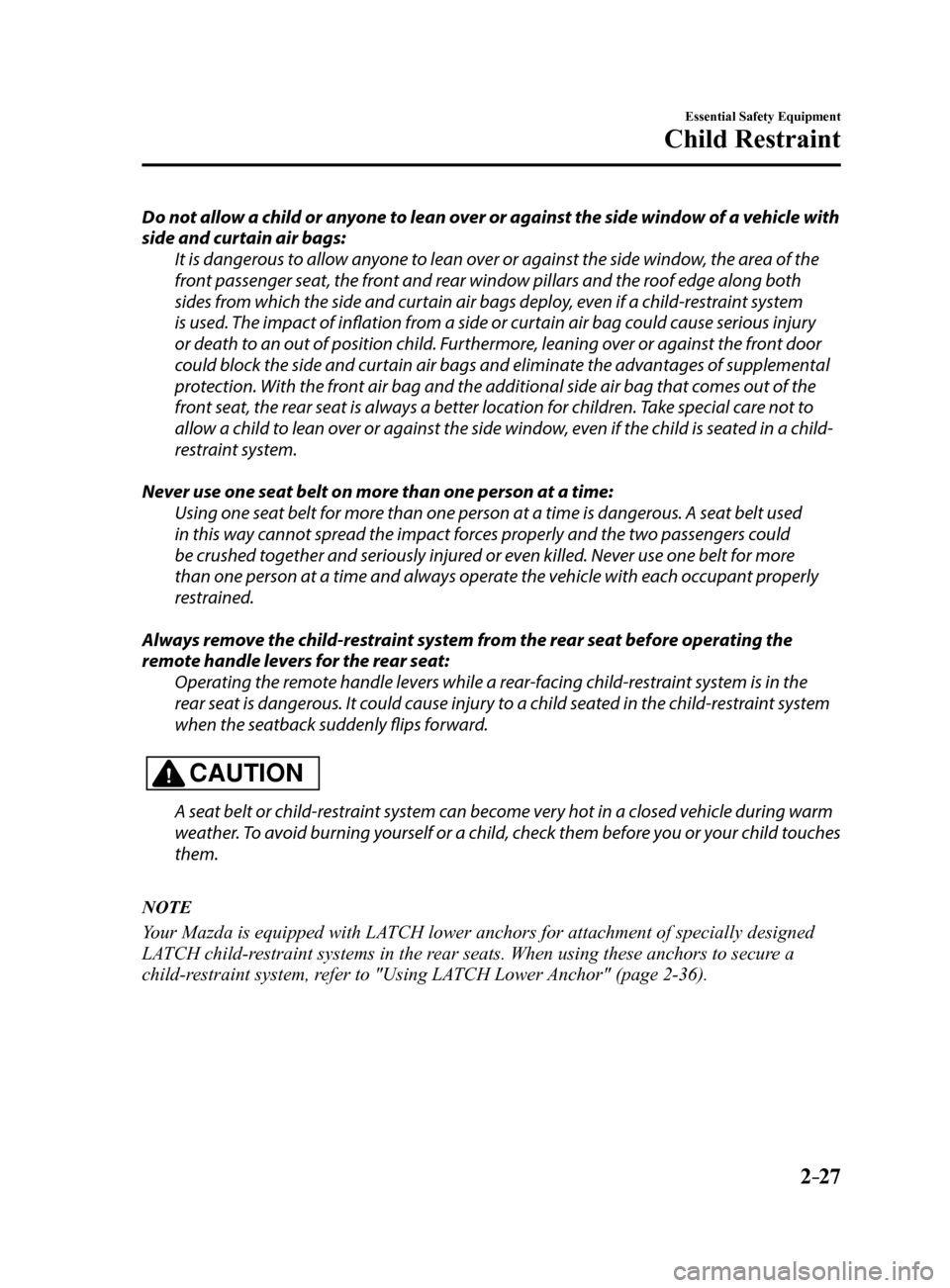
2–27
Essential Safety Equipment
Child Restraint
Do not allow a child or anyone to lean over or against the side window of a vehicle with
side and curtain air bags:It is dangerous to allow anyone to lean over or against the side window, the area of the
front passenger seat, the front and rear window pillars and the roof edge along both
sides from which the side and curtain air bags deploy, even if a child-restraint system
is used. The impact of inflation from a side or curtain air bag could cause serious injury
or death to an out of position child. Furthermore, leaning over or against the front door
could block the side and curtain air bags and eliminate the advantages of supplemental
protection. With the front air bag and the additional side air bag that comes out of the
front seat, the rear seat is always a better location for children. Take special care not to
allow a child to lean over or against the side window, even if the child is seated in a child-
restraint system.
Never use one seat belt on more than one person at a time: Using one seat belt for more than one person at a time is dangerous. A seat belt used
in this way cannot spread the impact forces properly and the two passengers could
be crushed together and seriously injured or even killed. Never use one belt for more
than one person at a time and always operate the vehicle with each occupant properly
restrained.
Always remove the child-restraint system from the rear seat before operating the
remote handle levers for the rear seat: Operating the remote handle levers while a rear-facing child-restraint system is in the
rear seat is dangerous. It could cause injury to a child seated in the child-restraint system
when the seatback suddenly flips forward.
CAUTION
A seat belt or child-restraint system can become very hot in a closed vehicle during warm
weather. To avoid burning yourself or a child, check them before you or your child touches
them.
NOTE
Your Mazda is equipped with LATCH lower anchors for attachment of specially designed
LATCH child-restraint systems in the rear seats. When using these anchors to secure a
child-restraint system, refer to "Using LATCH Lower Anchor" (page 2-36).
Mazda6_8FH2-EA-16F_Edition2.indb 272016/07/07 13:44:14
Page 41 of 578

2–29
Essential Safety Equipment
Child Restraint
Installing Child-Restraint
Systems
Accident statistics reveal that a child is
safer in the rear seat. The front passenger's
seat is clearly the worst choice for any
child under 12, and with rear-facing child-
restraint systems it is clearly unsafe due to
air bags.
NOTE
Even if your vehicle is equipped with
front passenger occupant classification
sensor (page 2-56), which automatically
deactivates the front passenger air bag, a
rear seat is the safest place for a child of
any age or size.
Some child-restraint systems now come
with tethers and therefore must be
installed on the seats that take tethers
to be effective. In your Mazda, tethered
child-restraint systems can only be
accommodated in the three positions on
the rear seat.
Some child-restraint systems also employ
specially designed LATCH attachments;
refer to "Using LATCH Lower Anchor"
(page 2-36).
WARNING
Tethered Child-Restraint Systems Work
Only on Tether-Equipped Rear Seats:Installation of a tether equipped
child-restraint system in the front
passenger's seat defeats the safety
design of the system and will result in
an increased chance of serious injury if
the child-restraint system goes forward
without benefit of being tethered.
Place tether equipped child-restraint
systems where there are tether
anchors.
Anchor Bracket
Anchor brackets for securing child-
restraint systems are equipped in the
vehicle. Locate each anchor position using
the illustration.
To install a child-restraint system, remove
the head restraint. Always follow the
instruction manual accompanying the
child-restraint system.
Anchor bracket location
Use the indicated anchor bracket locations
when installing a child-restraint system
equipped with a tether.
Anchor bracket
For left
For right
For center
*
1
*1
Except Mexico
Mazda6_8FH2-EA-16F_Edition2.indb 292016/07/07 13:44:15